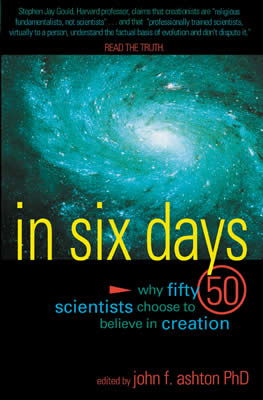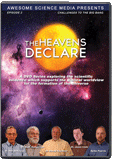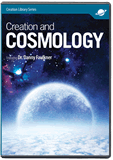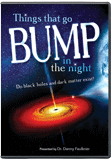Chapter 8
Keith H. Wanser, Physics
I am firmly convinced that there is far more scientific evidence supporting a recent, six-day creation and global Flood than there is an old earth and evolution.
is professor of physics, California State University, Fullerton. He holds a B.A. in physics from California State University, an M.A. in physics from the University of California, Irvine, and a Ph.D. in condensed matter physics from the University of California, Irvine. Dr. Wanser, who specializes in novel and ultrasensitive optical fiber sensor devices, components and techniques, has published over 30 refereed and 18 other technical papers and holds seven U.S. patents. In 1996 he was the recipient of the School of Natural Sciences and Mathematics Outstanding Research Award.
Being raised from early childhood in a church that believed in a literal six-day creation and having read the Bible often as a teenager, I believed in creation, although I did not understand the importance and centrality to the Christian faith of the first ten chapters of Genesis. When I attended a state university as an undergraduate and talked with the physics professors, I was ridiculed for believing that the earth was young, and given many reasons from science showing that the Bible was in error, especially the first chapters of Genesis. As a young college student majoring in physics, I did not know enough science to be able to refute what these professors were saying, and since they knew so much more than I, gradually I lost faith in the literal accuracy of Scripture, although I still believed in God. This led me to a period of a few years where I was a “theistic evolutionist,” morally adrift, and intensively reading a variety of scientific journals and books to try to find out the truth.
In 1976 I recommitted my life to Jesus Christ, and shortly thereafter began studying the scientific, historical, scriptural and other evidence for a literal six-day creation and worldwide global Flood, as described in Genesis. In the intervening 24 years since then, I have studied these bodies of evidence in some detail, and I am firmly convinced that there is far more scientific evidence supporting a recent, six-day creation and global Flood than there is an old earth and evolution.
There is far more scientific evidence supporting a recent, six-day creation and global Flood than there is an old earth and evolution.
One of the major problems with the so-called theory of evolution is that the details depend on who is telling the story. Those details that become commonly accepted as “facts” are often changed in light of more recent discoveries. This has happened on numerous occasions, with little notice that the supposed prior facts were not facts at all. In other words, there is not one theory of evolution, but a body of opinions, speculations and methods for interpretation of observational facts so that they fit into the philosophy of naturalism.
An example of a supposed fact demonstrating an ancient age of the earth is the rate of growth of stalactites and stalagmites in limestone caverns. As a young boy I toured Carlsbad Caverns in New Mexico and remember the tour guide informing us matter-of-factly that the limestone caverns and formations were formed over many millions of years, which did not seem to agree with what I had been taught in Sunday school. A sign above the entrance until 1988 said the caverns were at least 260 million years old. In recent years, the age on the sign was reduced to 7–10 million years, then 2 million years, and now the sign is gone perhaps as a result of observations that stalactite growth rates of several inches a month are common.1
Creationists have performed a significant body of research demonstrating the rapid development of calcium carbonate formations under conditions likely following the Noahic Flood. In May 1998 I observed stalactites longer than six inches growing from the edge of the concrete boarding platform at the Arlington, Virginia, metro rail station, which was only completed in June 1991. Another example of a supposed fact was the slow rate of petrifaction of wood, requiring long periods of time to occur. Petrifaction of wood has been shown to occur rapidly in highly silicified waters, and would likely have been accelerated by the conditions of a worldwide Flood. Indeed, a U.S. patent has been granted on a process to rapidly petrify wood so as to make it fire-and-wear resistant.2
Over the last 35 years, scientists who believe in a recent, six-day creation have made some very interesting discoveries and convincing arguments for a young earth and worldwide Noahic Flood. In essentially all cases, their research has not been supported by government funding. This is in contrast to the many millions of dollars of government-funded research by scientists who hold evolutionary presuppositions, which has been used to support their beliefs. In spite of these handicaps, a remarkable body of evidence refuting evolutionary notions has been assembled by creationists.3 They demonstrate that several processes which formerly were thought to require long periods of time actually occur rapidly, and testify to a young earth and recent creation. Furthermore, creationists are beginning to make testable predictions based on their theories, as well as become more quantitative in their modelling.
The catastrophic plate tectonics model that has been developed4 has served to help explain several geologic features that are associated with the Flood, as well as geomagnetic reversals and the post-Flood Ice Age. Early creationist work on the rapid, free induction decay of the earth’s magnetic field was able to explain the observed decay of about 7 percent in the field over the last 130 years, with no adjustable parameters, and set an upper limit to the age of the field of about 10,000 years.5 This theory was later modified to include local and rapid geomagnetic reversals associated with catastrophic plate tectonics and Noah’s Flood, and extended to include the size of planetary magnetic fields.6 Predictions based on this recent and biblical creation model were made about rapid geomagnetic reversals and planetary magnetic fields, which have been verified experimentally.7
The explanation of the planetary magnetic fields is in surprising agreement with the creationist theory and there is no evolutionary counterpart to it. Similarly, the predictions of rapid geomagnetic reversals have been verified by analysis of lava flows in Steen’s Mountain in Oregon, which indicate geomagnetic polarity reversals occurring in a matter of a few weeks, much to the bewilderment and surprise of evolutionary scientists.8
Major problems with evolutionary scenarios of origins occur at several stages. One very interesting problem occurs right at the beginning in theories of quantum cosmology, which predict that the big bang originated from a quantum fluctuation of the vacuum.9 Unfortunately, this speculation is nothing more than that, since in all experimentally observed processes involving elementary particles and nuclear reactions, something called Baryon number is conserved. The conservation of Baryon number insures that when particles are brought into existence from energy, they occur in equal numbers of matter/anti-matter pairs. Thus, in pair production, an electron and positron are produced; similarly, a proton and antiproton are produced. On the other hand, as far as we are able to observe, the universe appears to have an extreme dominance of matter over anti-matter, which contradicts the notion that a big bang produced the matter that we see in the universe around us.
Because of this problem, elementary particle physicists have proposed Grand Unified Theories, or GUTs, which hypothesize terms in the mathematical equations of the theory which violate Baryon number conservation, in order to produce a dominance of matter over anti-matter as a result of the big bang. Unfortunately, these theories predict that the proton is unstable and will decay, which has led to considerable experimental efforts to detect proton decay10. However, such searches have failed to find proton decay and have set lower limits on the proton lifetime of at least 10+31 years.11 The fact that there is no experimental evidence for violation of Baryon number conservation strongly calls into question any big-bang scenario for the origin of matter in the universe. There are several other problems with theories of quantum/big-bang cosmology, which have been discussed by Morris.12
An intriguing creationist theory has been proposed13 which involves a white hole cosmology, a bounded universe, an initial water mass and Einstein’s theory of general relativity. This cosmology allows for a literal six-day creation in the frame of reference of the earth (which is taken to be somewhere in the vicinity of the center of the universe), while long periods of time could elapse in other portions of the universe, thus allowing sufficient time for starlight to have travelled distances of billions of light years to reach the earth. It also allows for an expanding universe and red shifts, such as are observed. Other predictions of this theory, such as the temperature of the cosmic background radiation, have yet to be worked out in detail; nevertheless, this theory offers a viable alternative to naturalistic big-bang cosmology and solves the longstanding problem of light travel time in recent creation cosmologies.
Another creationist alternative to big bang cosmology has recently been proposed,14 which not only accounts for observed cosmological red shifts, but can also explain the 2.7 kelvin cosmic background radiation. Although these recent cosmological models are in their early stages, as compared to more than 50 years of refinement of the standard big bang model, they do demonstrate that the observed experimental facts may be understood without requiring a big bang. In addition, they demonstrate the originality and productivity of creationist scientists, contradicting claims by some evolutionists that creation scientists do not develop any new science.
One of the biggest stumbling blocks to belief in six-day creation is associated with radioisotope dating methods and the exceedingly old ages of rocks and fossils inferred from such methods. Recent work by creationists has shown that the widely used potassium-argon dating method suffers from fatal flaws in its assumption of no initial argon trapped in volcanic rocks at the time of their solidification.15 There have been various creationist proposals for accelerated radioactive decay and experimental searches for evidence that this has occurred in the past.16 Possible scenarios of intense neutrino and/or gamma ray fluxes due to various supernova and stellar disturbances (possibly during Noah’s Flood) may have contributed to the appearance of age when radioactive substances are examined by causing substantial radioactive decay in a very short time period, rather than over long periods of time at currently observable rates. Besides causing additional radioactive decay, such fluxes or increases in cosmic radiation could also have resulted in the rapid decrease in the human lifespan following the Flood, as recorded in Genesis. It is believed that the decrease of the earth’s magnetic field associated with catastrophic plate tectonics during Noah’s Flood also contributed to a dramatic increase in cosmic ray flux in the upper atmosphere and an attendant increase in the production of carbon 14.
An extremely large flux in gamma rays flooding the solar system was recently observed and is believed to be a relatively “common” occurrence.17 These extremely intense gamma ray emissions were attributed to a type of neutron star known as a magnetar. Magnetars are expected to dissipate their energy in about 10,000 years, an indication that they themselves are young.
In addition to proposals for accelerated nuclear decay, there has recently appeared experimental evidence that the decay of unstable quantum mechanical systems is nonexponential.18 On very general grounds, one may show that the decay of an unstable quantum mechanical system is nonexponential at short times. It is one of the largest extrapolations in science to assume that the decay of radioactive isotopes with half-lives of more than 10+9 years is exponential, when the exponential decay law for radioactive isotopes has only been experimentally verified for short-lived isotopes with half-lives less than 100 years. This is an extrapolation of at least 7 orders of magnitude in time! There are reasons to believe that the longer-lived radioisotopes should exhibit significant deviations from the exponential decay law. The rigorous quantum mechanical theory of the decay of long-lived radioisotopes is currently under investigation, in order to determine the size of the deviation from the exponential decay law at times short compared to the half-life. If significant deviations are found, this will completely alter the interpretation of radioisotope data and the inferred ancient chronologies, which are based on the assumption of the validity of the exponential decay law over unobservably large times.
Cited in this brief article is just a small sample of the interesting work that has been and is being done by scientists who believe in creation. The inquisitive reader is urged to study the books in the bibliography by Morris (see note 3). In addition, there are many internet websites19 with numerous articles which give scientific, historical and biblical evidences for a recent, six-day creation and the worldwide Noahic Flood.
In Six Days
Can any scientist with a Ph.D. believe in the idea of a literal six-day creation? In Six Days answers this provocative question with 50 informative essays by scientists who say “Yes!”
Read Online Buy BookFootnotes
- G.W. Wolfram, Carlsbad “Signs Off,” Creation Research Society Quarterly 31:34, June 1994; E.L. Williams, Cavern and Speleotherm Formation Science and Philosophy, Creation Research Society Quarterly 29:83–84, Sept. 1992; E.L. Williams, Rapid Development of Calcium Carbonate Formations, Creation Research Society Quarterly 24:18–19, June 1987.
- E.L. Williams, Rapid Petrifaction of Wood, Creation Matters 1:1, Jan. 1996; E.L. Williams, Fossil Wood from Big Bend National Park, Brewster County Texas: Part II, Creation Research Society Quarterly 30:106–111, Sept. 1993; H. Hicks, Sodium Silicate Composition, U.S. Patent #4,612,050, Sept. 16, 1986.
- Henry M. Morris, A Young-Earth Creationist Bibliography, Institute for Creation Research Impact article No. 269, November 1995.
- S.A. Austin et al., Catastrophic Plate Tectonics: A Global Flood Model of Earth History, Proceedings of the Third International Conference on Creationism, pp. 609–621, 1994; C. Burr, The Geophysics of God, U.S. News and World Report, July 16, 1997.
- Thomas G. Barnes, Origin and Destiny of the Earth’s Magnetic Field, Creation Research Society, El Cajon, CA, p. 132, 1983.
- R. Humphreys, The Earth’s Magnetic Field is Young, Institute for Creation Research Impact article No. 242, August 1993.
- D.R. Humphreys, Physical Mechanism for Reversals of the Earth’s Magnetic Field During the Flood, Proceedings of the Second International Conference on Creationism 2:129–142, 1990 (Creation Science Fellowship, Pittsburgh, PA, USA) and references therein.
- R.S. Coe, M. Prevot, and P. Camps, New Evidence for Extraordinarily Rapid Change of the Geomagnetic Field During a Reversal, Nature 374:687–692, April 20, 1995.
- D. Atkatz, Quantum Cosmology for Pedestrians, American Journal of Physics 62:619–627, July 1994.
- Graham G. Ross, Grand Unified Theories, Benjamin/Cummings, Menlo Park, CA, pp. 212–216, 438–444, 1984.
- R. Mathews, Rock Solid, New Scientist, pp. 48–52, May 22, 1999.
- Henry M. Morris and John D. Morris, The Heavens Don’t Evolve Either, The Modern Creation Trilogy, vol. 2, Science and Creation, Master Books, Inc., Green Forest, AR, pp. 203–232, 1996.
- D. Russell Humphreys, Starlight and Time, Master Books, Green Forest, AR, pp. 83–133, 1994.
- R.V. Gentry, A New Red Shift Interpretation, Modern Physics Letters A 12(37):2919–2925, 1997. Also see e-prints: The New Red Shift Interpretation Affirmed, and The Genuine Cosmic Rosetta.
- A. Snelling, “Excess Argon”: The “Achilles Heel” of Potassium-Argon and Argon-Argon “Dating” of Volcanic Rocks, Institute for Creation Research Impact Article No. 307, January 1999 and references therein.
- J.W. Bielecki, Search for Accelerated Nuclear Decay with Spontaneous Fission of 238U, Proceedings of the Fourth International Conference on Creationism, pp. 79–88, 1998.
- R. Cowen, Crafts Finds New Evidence of Magnetars, Science News 154:164, Sept. 12, 1998.
- S.R. Wilkinson et al., Experimental Evidence for Non-exponential Decay in Quantum Tunneling, Nature 387:575–577, June 5, 1997.
- Two internet websites with information on creation/evolution are: Institute for Creation Research, Christiananswers.net, and Answers in Genesis.
Recommended Resources

Answers in Genesis is an apologetics ministry, dedicated to helping Christians defend their faith and proclaim the good news of Jesus Christ.
- Customer Service 800.778.3390
- © 2024 Answers in Genesis






